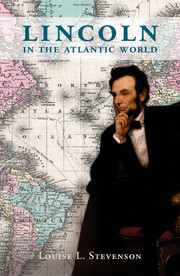Book contents
- Frontmatter
- Dedication
- Contents
- Acknowledgments
- Introduction: My Lincoln Lessons
- 1 The Second Shot Heard ’Round the World
- 2 African Lessons
- 3 European Lessons
- 4 German Lessons
- 5 English Lessons
- 6 Lessons from International Law
- 7 German Lessons for Reelection
- 8 The Last Lesson
- Notes
- Selected Bibliography
- Index
6 - Lessons from International Law
Published online by Cambridge University Press: 05 November 2015
- Frontmatter
- Dedication
- Contents
- Acknowledgments
- Introduction: My Lincoln Lessons
- 1 The Second Shot Heard ’Round the World
- 2 African Lessons
- 3 European Lessons
- 4 German Lessons
- 5 English Lessons
- 6 Lessons from International Law
- 7 German Lessons for Reelection
- 8 The Last Lesson
- Notes
- Selected Bibliography
- Index
Summary
In August 1863, a month after the decisive Union victories at Gettysburg, Pennsylvania, and Vicksburg, Mississippi, John Hay, Lincoln's private secretary, felt sufficiently confident to predict: “the rebellion is nearing its close.”
Heartened by those battlefield successes, artist Francis Bicknell Carpenter dreamed of a monumental painting to commemorate a pivotal event in United States and world history. (See Figure 6.1.) It would depict the moment, almost a year previously, on July 22, 1862, when, he believed, a “new epoch in the history of Liberty” had begun. When Lincoln announced his plans for emancipation to his assembled cabinet members, Carpenter projected, the Union started toward its triumph and slavery's end. The ardent antislavery supporter, who had voted for John Frémont in 1856, recalled that he always had thought that victory over a rebellion “with slavery at its corner-stone” required the Union to strike “a death-blow at the institution itself.” When Lincoln composed and read the Emancipation Proclamation to his cabinet, Carpenter believed that the Lincoln administration had armed itself to strike such a blow.
The artist envisioned the conflict with the Confederate States in apocalyptic, Christian terms as the battle between the rebel angel Lucifer and the loyal angels of God. Carpenter located the moment of right, when the evil angel had to face his inevitable defeat, with Lincoln's first reading of the Emancipation Proclamation to his cabinet, in the cabinet room at the Executive Mansion. By naming July 22 as the date when the federal government embraced the cause of right, or the side of the angels, Carpenter moved the story of the Emancipation Proclamation away from battlefields, the agency of the enslaved people themselves, and the actions of Congress. Moreover, he minimized the role of Congress, the military, and the Lincoln administration as it proceeded during its first fifteen months in office to surround the slave South with areas of freedom, for example by joining with Great Britain to end the slave trade. By centering the painting on Lincoln and his cabinet in the Executive Mansion, Carpenter created a visual polemic awarding the Emancipation Proclamation and its author the central role in the ending of human slavery in the United States. His painting helped mythologize Lincoln as the “Great Emancipator” while leaving unnoticed, as this chapter will show, crucial events of 1861 and 1862.
- Type
- Chapter
- Information
- Lincoln in the Atlantic World , pp. 158 - 185Publisher: Cambridge University PressPrint publication year: 2015



